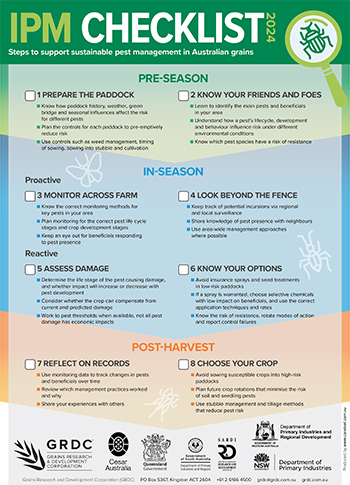A step-by-step guide that supports sustainable pest management practices throughout a crop growing season is now available for download
Integrated pest management (IPM) is a year-round effort, during which key actions need to be taken at all stages of production.
To capture the essence of those decision points, a team of IPM researchers and experts have compiled a pest management almanac that takes the form of a downloadable, one-page checklist.
The IPM Checklist breaks the process down to eight steps. These are structured into pre-season, in-season and post-harvest periods. Each step summarises the key actions and decisions needed to manage pests in the most sustainable, productive way possible.
Published in June 2024, the checklist is one of the products of a GRDC investment called ‘IPMforGrains’.
 IPM Checklist. Photo: GRDC
IPM Checklist. Photo: GRDC
That project (now completed) was led by Cesar Australia, an independent research and extension company. It was undertaken in collaboration with the Queensland Department of Agriculture and Fisheries (QDAF), the NSW Department of Primary Industries and Regional Development (NSW DPIRD), the South Australian Research and Development Institute (SARDI) and the WA Department of Primary Industries and Regional Development (DPIRD).
IPMforGrains project activities included regional training workshops, presentations, webinars, regional pest updates and real-time support when pest outbreaks occurred. It also included industry consultation as part of the development of the checklist.
Cesar Australia entomologist Dr Lizzy Lowe says the IPM checklist is designed to simplify the vast amount of information available on how to implement IPM, and facilitate its uptake by growers and agronomists.
“With challenges like insecticide resistance and changing chemical regulations, the need for a broader range of effective pest control solutions has never been more pressing,” Dr Lowe says.
“So, with the IPM checklist, we have provided a structure for how to plan and implement IPM.
“This meant distilling out the critical components to provide a framework for identifying what information, skills and knowledge is needed for on-farm implementation.”
Emphasised are the often-overlooked proactive measures that allow growers to stay one step ahead of pests and prevent problems from becoming economically damaging.
“The IPM checklist is intended as a road map for being prepared and for keeping on top of actions required across the season,” Dr Lowe says.
She says substantial benefits are possible from adopting the checklist process.
Download a PDF of the checklist.
More information: Paul Umina, pumina@cesaraustralia.com

























































